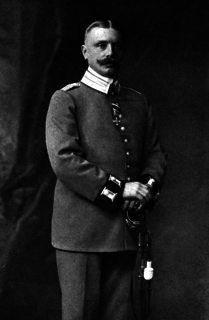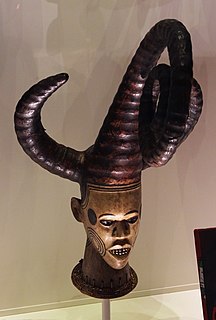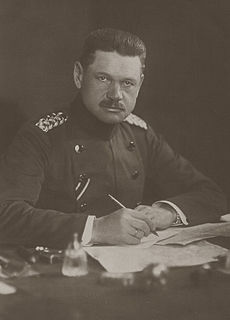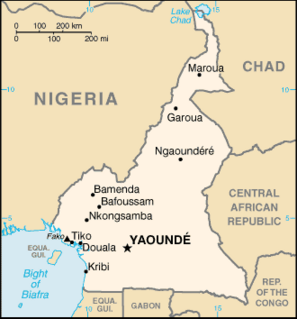At the crossroads of West Africa and Central Africa, the territory of what is now Cameroon has seen human habitation since some time in the Middle Paleolithic, likely no later than 130,000 years ago. The earliest discovered archaeological evidence of humans dates from around 30,000 years ago at Shum Laka. The Bamenda highlands in western Cameroon near the border with Nigeria are the most likely origin for the Bantu peoples, whose language and culture came to dominate most of central and southern Africa between 1000 BCE and 1000 CE.

Kamerun was an African colony of the German Empire from 1884 to 1916 in the region of today's Republic of Cameroon. Kamerun also included northern parts of Gabon and the Congo with western parts of the Central African Republic, southwestern parts of Chad and far eastern parts of Nigeria.

The German colonial empire constituted the overseas colonies, dependencies and territories of the German Empire. Unified in the early 1870s, the chancellor of this time period was Otto von Bismarck. Short-lived attempts at colonization by individual German states had occurred in preceding centuries, but Bismarck resisted pressure to construct a colonial empire until the Scramble for Africa in 1884. Claiming much of the left-over uncolonized areas of Africa, Germany built the third-largest colonial empire at the time, after the British and French. The German Colonial Empire encompassed parts of several African countries, including parts of present-day Burundi, Rwanda, Tanzania, Namibia, Cameroon, Gabon, Congo, Central African Republic, Chad, Nigeria, Togo, Ghana, as well as northeastern New Guinea, Samoa and numerous Micronesian islands. Including mainland Germany, the empire had a total land area of 3,503,352 square kilometers and population of 80,125,993 people.

Prince Hermann Ludwig Heinrich von Pückler-Muskau was a German nobleman, renowned as an accomplished artist in landscape gardening, as well as the author of a number of books mainly centering around his travels in Europe and Northern Africa, published under the pen name of "Semilasso".
Articles related to Cameroon include:

Limbé is a seaside city in the South-West Region of Cameroon. At the 2005 Census, the population was 84,223.

Buea is the capital of the Southwest Region of Cameroon. The city is located in Fako Division, on the eastern slopes of Mount Cameroon, and has a population of 300,000. It has two Government Hotels, the Mountain Hotel and Parliamentarian Flats Hotel located around The Government Residential Area. The self-declared state of Ambazonia claims the city as its capital.

Mamfe or Mamfé is a city in and the capital of Manyu, a division of the Southwest Region in Cameroon. It is 74 km (46 mi) from the border of Nigeria, on the Manyu River. It has a population of 36,500.
The Vengo, or Babungos, are an ethnic group of about 14,000 people who are resident in the anglophone Northwest Province of Cameroon. They live predominantly in the region of a village which is also called Vengo or "Babungo". This village is located in the Cameroonian Grassfields at the so-called "Ringroad", approximately 50 km West of the province's capital Bamenda. The language of the people is also called Vengo or "Babungo". For the tribe, village and language the spelling "Bamungo" is also often found.

German West Africa (Deutsch-Westafrika) was an informal designation for the areas in West Africa that were part of the German Colonial Empire between 1884 and 1919. The term was normally used for the territories of Cameroon and Togo. German West Africa was not an administrative unit. However, in trade and in the vernacular the term was sometimes in use.

Hans Dominik was a German colonial officer of the Schutztruppe. He was the long-time commander of the Jaunde military station in Kamerun.

Ekoi people, also known as Ejagham, are an ethnic group in the extreme south of Nigeria and extending eastward into the southwest region of Cameroon. They speak the Ejagham language. Other Ekoi languages are spoken by related groups, including the Etung, some groups in Ikom, some groups in Ogoja, Ufia and Yakö. The Ekoi have lived closely with the nearby Efik, Annang, Ibibio and Igbo people of southeastern Nigeria. The Ekoi are best known for their Ekpe headdresses and the Nsibidi text. They traditionally use Nsibidi ideograms, and are the group that originally created them.

Baroness Wilhelmine Caroline Christiane Henriette of Dörnberg, was a member of the House of Dörnberg and a Baroness of Dörnberg by birth. Through her marriage to Maximilian Karl, 6th Prince of Thurn and Taxis, Wilhelmine was also a member of the House of Thurn and Taxis. Wilhelmine was known to her family and friends as "Mimi."
Dume district was an administrative unit in Cameroon during the German colonial rule.

Mundame or Moundamé is a community in Cameroon, in the Southwest Region, about 2 kilometres (1.2 mi) from the Mungo River. The river is navigable south of Mundame for about 100 kilometres (62 mi) as it flows through the coastal plain before entering mangrove swamps, where it splits into numerous small channels that empty into the Cameroon estuary complex.

Jantzen & Thormählen was a German firm based in Hamburg that was established to exploit the resources of Cameroon. The firm's commercial and political influence was a major factor in the establishment of the colony of Kamerun in 1884.

The Kamerun campaign took place in the German colony of Kamerun in the African theatre of the First World War when the British, French and Belgians invaded the German colony from August 1914 to March 1916. Most of the campaign took place in Kamerun but skirmishes also broke out in British Nigeria. By the Spring of 1916, following Allied victories, the majority of German troops and the civil administration fled to the neighbouring neutral colony of Spanish Guinea. The campaign ended in a defeat for Germany and the partition of its former colony between France and Britain.

Curt Ernst von Morgen was a Prussian explorer and officer, later General of Infantry during World War I. He was a recipient of Pour le Mérite with Oak Leaves.
Veilchen (Violet) was a wolfpack of German U-boats that operated during the World War II Battle of the Atlantic from 20 October 1942 to 7 November 1942.

The Cameroon–Nigeria border is 1,975 km in length and runs from the tripoint with Chad in the north to the Atlantic Ocean in the south.